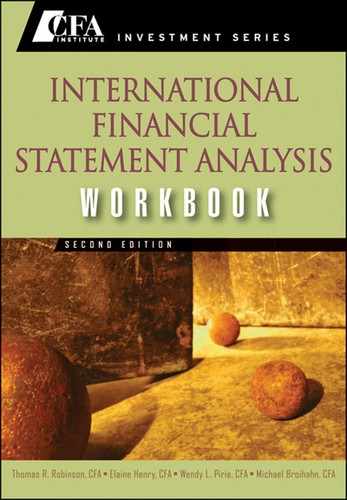CHAPTER 16
EVALUATING FINANCIAL REPORTING QUALITY
1. A is correct. Because debt covenants typically mandate a certain level of financial performance, they can serve to encourage rather than discourage earnings manipulation.
2. B is correct. Earnings quality is typically defined in terms of persistence and sustainability. By contrast, earnings may be manipulated to deliver steady growth. Conservatism in accounting choices may reduce the persistence of earnings as the accounting often reverts to the mean over time.
3. B is correct. Accrual accounting is based on the “matching principle” under which revenues and the associated expenses are recognized concurrently even when the cash flow timing may differ.
4. B is correct. Cash accounting does not rely on discretionary estimates but rather on actual cash flows. This may be either more or less conservative than accrual-based accounting.
5. B is correct. A is the balance sheet aggregate accrual measure, while C is the cash flow aggregate accrual measure.
6. A is correct. Net operating assets=(Assets−Cash and short-term investments)−(Liabilities−Total debt), or in Profile’s case, (97,250−14,000)−(87,000−50,000)=46,250 in 2007 and 40,800 in 2006. The accrual ratio in 2007 is the change in NOA divided by average NOA, or (46,250−40,800)/[(46,250+40,800)/2]=5,450/43,525=12.5%.
7. C is correct. The accrual ratio is [NI−(CFO+CFI)]/NOA or [14,000−(17,300−12,400)]/39,000=9,100/39,000=23.3%.
8. A is correct. Sales=Cash collected from customers+Increase in accounts receivable−Increase in deferred revenue.
9. A is correct. Reported sales results are affected by management’s estimates of, among other things, uncollectible receivables, warranty costs, and returns.
10. A is correct. Cash collected from customers=Sales−Net increase in accounts receivable+Net increase in deferred revenue. Cash collected from customers=14.3 billion sales−0.7 billion increase in receivables+0.5 billion increase in unearned revenue=€14.1 billion.
11. B is correct. Revenue was increased by a $3 million accrual for the change in receivables and also by the $4 million reduction in deferred revenue. Accrual-basis earnings were therefore $7 million.
12. C is correct. The allowance for doubtful accounts excludes items from reported revenue and accounts receivable. An increase in this account reduces the discretionary accrual related to the change in accounts receivable.
13. A is correct. Deferred/unearned revenue represents cash collected from customers that will be recognized as revenue in the future. A decrease in this account means the revenue has been recognized. An unexpected decrease could signal accelerated revenue recognition.
14. A is correct. Ending receivables should be adjusted to add the €2 million of securitized receivables. Then cash collections can be calculated as €137−(5+2)=€130.
15. B is correct. By increasing the residual value estimate, management would lower the total depreciation expense to be recognized over time.
16. B is correct. A rise in inventory balances could suggest poor inventory management efficiency, or also that costs that should be recognized in cost of goods sold are being capitalized as inventory. It would not affect the revenue line.
17. C is correct. PP&E growing at a faster rate than sales may indicate that expenses are being inappropriately capitalized.
18. C is correct. An asset write-down increases expense in the current year, but reduces depreciation in future periods (and possibly indicates that depreciation was too low in prior periods).
19. B is correct. Core operating margin is (Sales−COGS−SGA)/Sales, or (93,000− 24,500−32,400)/93,000=36,100/93,000=38.8%.
20. C is correct. Although COGS/Sales improved and SGA/Sales deteriorated, the total effect was no change. 17,140/42,340=40.5% and 18,854/46,574=40.5%.
21. C is correct. One way to spot misclassification of ordinary expenses is to look for spikes in the incidence of special items for companies that previously experienced decreasing core operating margin.
22. A is correct. Capital leases are treated as though the related asset were purchased and financed using debt.
23. B is correct. The future payments should be discounted to the present value at a rate approximating the company’s cost to finance debt of a similar nature.
24. B is correct. Goodwill is charged to expense only if it becomes impaired.
25. C is correct. Stock-based acquisitions do not flow through the cash flow statement.
